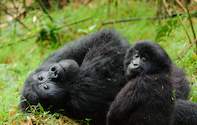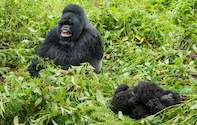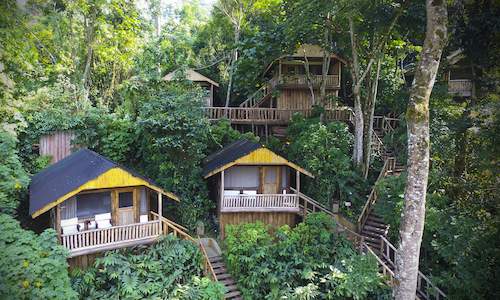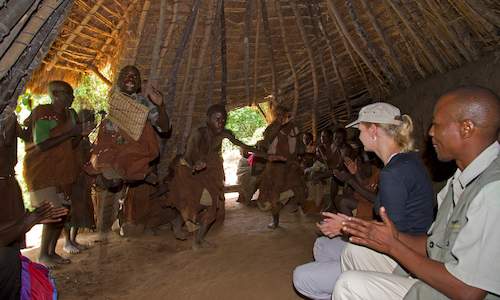
Depending on, what you read there is one species of great ape in the jungles of central Africa and it is classified scientifically as Gorilla. Or else there are two species, C gorilla and C beringei separated west and east of the Congo River respectively.
The name given to the group by American missionary Thomas Staughton Savage and naturalist Jeffries Wyma was derived from a specimen obtained in what is today Liberia. It comes from the writings of the ancient Greek Hanno, who described a tribe of hairy women along the coast of Africa that he called the Gorillae.
The first specimens to reach England, and later America, were 20 skins of western lowland gorillas that arrived there in 1859. They were carefully chaperoned by a most unlikely explorer and naturalist, the shy and diminutive French American Paul du Chaillu. He had personally shot them while exploring modern-day Gabon, where he had grown up living with a missionary family.
While the taxonomy of the genus is still µp for much debate there, is a general agreement where gorillas came from. The key concept to bear in mind in matters of evolution is that one living organism does not evolve from another, but that both derive from some former, extinct one, in effect replacing it. So humans have not evolved from apes, or monkeys, but from a common primitive primate ancestor that lived around 30 million years ago.
The first hominoid fossils are known from East Africa, dated around 20 million years ago. But 10 million more years elapsed before a group of primates emerged and from which humans and apes split. It is not known what was the exact ancestor of the mountain gorilla. We can. however, trace their family lineage back to an early proto-ape named Proconsul africanus that lived there nine million years ago.
The first mountain gorillas noted in the scientific literature were two "fine specimens" shot by Schutzrruppe Captain Robert von Beringe in 1902. skins to the Natural History Museum of Berlin where they described this new species and named it in his honour.
As a result of the colonial carving up of the region and subsequent conflicts, compound socio-economics, there are now two distinct populations of mountain gorillas: one occurs in the Virunga volcanic where Uganda, Rwanda and the DRC meet, and the other just a days’ walk away in Uganda's Bwindi Impenetrable Forest.
Current estimates pin numbers at between 800 and 900, split pretty much equally between the two areas. The species is designated as being endangered, its survival depends entirely on conservation to high protection status at Bwindi, the 400-plus found there is arguably the most important remaining community.
Mountain gorillas live in family units numbering around 10 to 12 members strong and powerful, they are generally gentle and shy and will arrack only if first attacked. The group is lorded over by an alpha male, the silverback, who displays a regal silver back saddle and prominent hair crest. A silwerback gorilla reigns for an average of five years before he is ousted in a fearsome confrontation.
Mountain gorillas eat mainly new shoots and leaves but also the stems of nettles and strip the mountain bamboo to get at the soft pith inside. While most are at home on the ground, they will take advantage of any fruiting trees and a small part of their diet comprises termites and ants. A fully-grown male mountain gorilla weighs up to 200 kilograms and eats around 35 kilograms of vegetation a day; a female, half that size, requires about half of that amount.
They forage in the early morning, knuckle-walking through the dense Jungle. Towards late morning they will rest up, then in the cooler afternoon begin foraging again until evening. As dusk. approaches, each member of the group makes its own nest on the ground, with the exception of infants who share with their mothers.
Bwindi Impenetrable Forest, where the Ugandan half of the Mountain gorilla species lives, is located in southwestern Uganda on the edge of the western or Albertine arm of the Great Rift Valley, between 1,160 and·2,607 metres altitude.
In the local Runyakitara language, one of 41 languages spoken in Uganda, Bwindi means dark, or dense. So "bwindi impenetrable" is something of a tautology - unless you have ever tried to penetrate the dense undergrowth beneath the canopy, then you would know it was not.
Partly on account of its vast age, combined with its wet tropical location, Bwindi is one of the most diverse forests in East Africa. There are more than 200 tree species, most of them endemic, some 104 fern species and it is perhaps the most important refuge for montane forest butterflies with 202 species. Birders will be richly rewarded with an estimated 350 species, 23 of which are endemic to the Albertine Rift and a further 12 recorded nowhere else in Uganda.
Friends and Foes

In 1991, in order to conserve the remaining 32,092 hectares of old-growth forest, Bwindi was declared a national park, the population of Batwa or Pygmy hunter-gatherers and slash-and-burn farmers moved out beyond the fringes. At that time there were fewer than 300 gorillas left in the forest. In 1994 the park was declared a World Heritage Site.
It was population pressure and the battle for dwindling resources that led directly to the unexpected outbreak of violence across the border in Rwanda in the 1990s. As always happens in these cases, the biggest victims are the innocent bystanders, which in this case included the mountain gorillas.
Add to that the besieging human populations and encroaching slash-and-burn agriculture on the rich volcanic mountainsides, expanding villages and logging, and you can see why the gorillas, might have a world-court case against humankind.
The first person to seriously study mountain gorillas was George Schaller. In 1959, at age 26, he set up camp in the Kabara Meadow in Congo-Kinshasa, to commune with mountain gorillas. At this time, another primatologist of note as well as one that became the world's outstanding palaeontologist, Louis Leakey, was setting the scientific world alight with discoveries of ancient apes, ape-men and man-apes in East Africa.
It was Leakey who persuaded Jane Goodall, Birute Galdikas and Dian Fossey to go off into the wilds of Africa and Borneo to study chimpanzees, orangutans and mountain gorillas respectively. They became known as Leakey's "trimates" and just about all we know today about the great apes we know from them.
Researcher and conservationist Dian Fossey arrived in the Congo in 1967, and also set up camp in Karaba Meadow. After just a short sojourn she was forced to flee the Congo and found refuge in the mountains of Rwanda where. she put down the roots of Karisoke Camp. From early on she started making close bonds with the gorillas - how could she not! But from equally early on she started making human adversaries.
After 18 years garnering increasing international fame as well as local infamy, a research assistant found her murdered body in her cabin one morning in December 1985. The last entry in her diary read: "When you realize the value of all life, you dwell less on what is past and concentrate more on the preservation of the future."
Although chimpanzees are the closest living relatives to humans, it is gorillas that most remind us of ourselves. Visitors, young and old, slim and not so, are happy to endure what for many people will be the most challenging walk of their lives, to enjoy a one hour encounter with the mountain gorillas.
This is a rainforest, so expect to get wet, the actual wet seasons of April-May and November being especially so. The Bwindi forest itself should not be overlooked in your concern to find gorillas. It is one of the most absorbing habitats in Africa with overwhelming variety and enchantment. In places, it is dense and gloomy, while in others sunlight penetrates the canopy and illuminates foliage, flowers and a spindrift of butterflies.
Gorilla Trek in Bwindi

Once you attain the ridge lines the gradient levels off and you will get a chance to catch your breath. The trees here have thinned out and the gorillas tend to gather in glades dominated by the bamboo they like to feed on.
Silverbacks and their troops are usually named by the trackers after the place they were born or first seen. The first troop to be habituated in Bwindi was the Mubare group, in 1993, which is currently led by the silverback Kanyonyi. They number 11 plus one infant. Since then 10 more troops have become habituated to human presence. The Rushengura group numbers 14 mature gorillas and are ruled by a black-back, a male that has not yet attained its silver saddle.
In spite of the protection afforded them in the national park, the gorillas are still highly at risk from even the most well-meaning admirers. With such close genetic links, gorillas are vulnerable to many of the same diseases carried by humans, but often without sufficient immunity. At your briefing it will be stressed that you should not approach closer than seven metres to any animal and anyone suffering from a cold will be excluded from the trekking party.
Besides the guides and trackers who are in the national park service, a number of the Batwa people who used to live in, and off, the forest, supplement their income by working as porters. It is left up to you to decide how much you need their services. When making that decision the most important factor to consider is, not how much they will ease your own passage, but how much the gorillas need them to be gainfully employed and not be forced back into the forest to survive.
By David Bristow

 Guests at this Gorilla safari lodge in Bwindi Impenetrable Forest National Park, Uganda can enjoy top quality, intimate accommodation on the...
Guests at this Gorilla safari lodge in Bwindi Impenetrable Forest National Park, Uganda can enjoy top quality, intimate accommodation on the... Go on thrilling gorilla tracking adventures in this 4-day Bwindi Impenetrable National Park Gorilla Trek in Uganda....
Go on thrilling gorilla tracking adventures in this 4-day Bwindi Impenetrable National Park Gorilla Trek in Uganda....